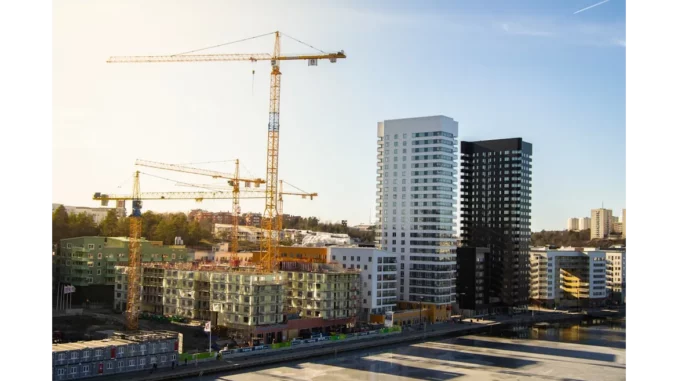
Situated in the heart of Cheshire, Warrington is on the brink of a transformative journey. With the ratification of the Local Plan by Warrington Borough Council in December 2023, the south-east region of the town is poised for a substantial overhaul. This strategic blueprint, which envisages the development of approximately 4,200 new homes, along with schools and a health hub, aims to address the burgeoning housing demands while underscoring sustainability and robust community engagement.
Focus360 Energy: property compliance services – pre-planning to post-construction. Learn more.
Homes England, the government’s housing and regeneration agency, is spearheading this ambitious initiative. The proposed extension targets areas encompassing Grappenhall, Grappenhall Heys, Appleton, and Stretton, embedding sustainability at the core of its design. This development is not merely about meeting present needs but also about preserving the environment for future generations.
A pivotal aspect of this project is the emphasis on community engagement. Homes England has orchestrated events enabling residents to interact with the project team, gain insights into the plans, and contribute their perspectives. This approach underscores the agency’s commitment to working synergistically with the local community to understand their views and aspirations. A spokesperson for Homes England highlighted, “We encourage people to have their say and help shape the plans.” This collaborative approach ensures that the development resonates with the needs and desires of the residents, instilling a sense of ownership and pride within the community.
The Local Plan outlines the delivery of a minimum of 14,688 new homes between 2021-22 and 2038-39, averaging 816 homes annually. The planned extension to south-east Warrington will substantially contribute to this target, with around 4,200 homes slated for construction, 30 percent of which will be affordable. This addresses the pressing need for accessible housing options, with at least 2,400 of these homes expected to be completed within the Local Plan period, before March 2039. This phased approach ensures a steady supply of housing while concurrently developing the necessary infrastructure.
The development plans extend beyond housing to encompass essential community facilities. Two two-form entry primary schools, each with the potential for expansion to three forms of entry, and a new secondary school providing a minimum of four forms of entry, are integral to the project. These institutions will cater to the growing population, ensuring children have access to quality education within their community.
Health and wellness are equally prioritised, with plans for a new leisure facility incorporating health provisions. This facility will complement the proposed expansion of the Appleton Cross GP health centre, ensuring residents have access to essential healthcare services. Local shops and other community facilities of an appropriate scale will further enhance the residents’ quality of life, creating a vibrant and self-sustaining community.
Despite the ambitious vision, there are concerns among residents and local representatives. The town’s Liberal Democrats, led by Cllr Mark Browne and Cllr Helen Speed, have emphasised the importance of influencing these wide-ranging developments. They stress the need for housing that meets the local population’s needs, particularly affordable homes and sustainable communities. The lack of infrastructure developments in areas like Grappenhall Heys over the past two decades has been a significant disappointment for residents. However, ongoing discussions with Homes England demonstrate a commitment to coordinating work on the neighbourhood plan and the development framework. This collaborative effort aims to address critical areas such as traffic management, transport, community and health centres, and the protection and enhancement of green infrastructure.
A significant facet of the development is the extensive green infrastructure network. The plans include playing pitches and other recreational spaces, promoting an active and healthy lifestyle among residents. The integration of green spaces not only enhances the area’s aesthetic appeal but also contributes to environmental sustainability. The Appleton Cross local centre is designed to support both existing and future communities, providing a health centre and amenities that serve the local area, ahead of the wider urban extension. This proactive approach ensures the necessary infrastructure is in place to support the growing population.
The transformation of Warrington’s green belt signifies a delicate equilibrium between development and preservation. While the necessity for new housing and infrastructure is undeniable, it is crucial to ensure the unique character and environmental integrity of the area are preserved. Critics argue that removing land from the green belt for development encroaches into the countryside, potentially compromising the visual amenities and local character. However, proponents highlight the pressing need for housing and the potential benefits of a well-planned, sustainable community.
Warrington’s green belt transformation is a complex and multifaceted process. With a focus on community engagement, comprehensive infrastructure, and environmental sustainability, the project promises to create a thriving and inclusive community. As plans progress, it is vital for all stakeholders to collaborate, ensuring the development meets residents’ needs and aspirations while preserving Warrington’s unique character. Striking a balance between development and preservation will undoubtedly be challenging, but with a collaborative approach and a commitment to sustainability, Warrington can anticipate a future that honours its past while embracing new opportunities.


Be the first to comment